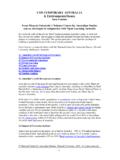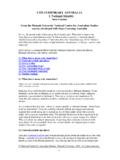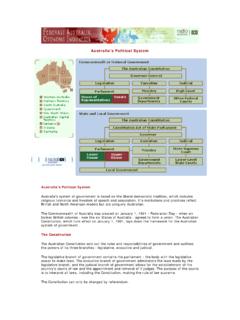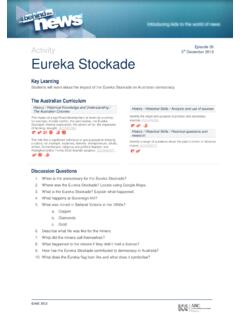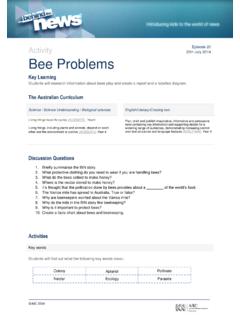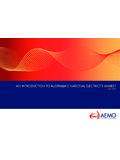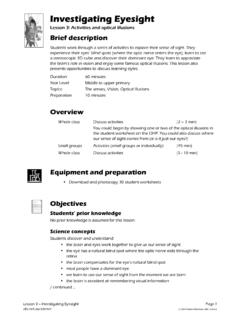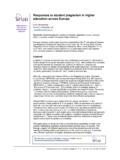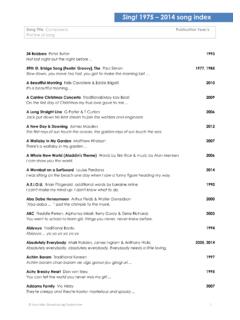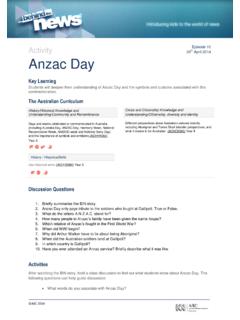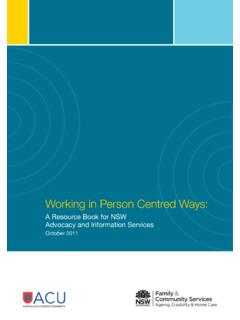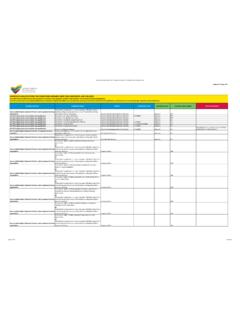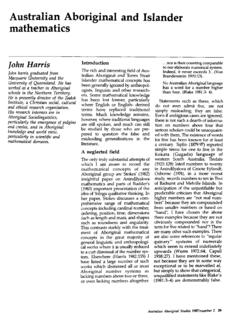Transcription of Week 2 – National Identity
1 CONTEMPORARY AUSTRALIA 2. National Identity Sara Cousins From the Monash University National Centre for Australian Studies course, developed with Open Learning Australia In this, the second week of the course, Sara Cousins asks: What does it mean to be Australian in a multicultural society? Is there an elusive quality, a National Identity , which binds us all as Australians? And what about the Australian way of life ? Does it still reflect the traditional virtues of egalitarianism, classlessness, a fair go , stoicism and mateship? Sara Cousins is a research fellow with the National Centre for Australian Studies, Monash University, Melbourne, Australia.
2 What does it mean to be Australian? National symbols and places Terra Nullius The Australian Type The Australian Way of Life Post-nationalist Australia? Further reading What does it mean to be Australian? There is no real Australia waiting to be uncovered. A National Identity is an invention. Richard White (1981) Inventing Australia Each one of us could describe ourselves with a multitude of different identities. These identities can be seen as defining us as people and may be cultural, ethnic, religious, gendered, class-oriented or ideological. They are as varied as our imagination.
3 In Australia, the religious, cultural and ethnic complexity of our society is particularly diverse. In the midst of this diversity, is there an elusive quality, a National Identity , which binds us all as Australians? There are certainly National cultural stereotypes and National symbols that we all recognise as Australian, but do these really reflect the everyday reality of living as an Australian today? Do National identities ever have anything to do with cultural experience or are they more to do with a constructed image of a nation ? What is it about our cultural stereotypes, if anything, that continues to resonate with Australians?
4 Who is excluded? Does our National Identity still depend upon a white Anglo-Celtic male viewpoint? National symbols and places National Centre for Australian Studies, Monash University, 2005. All rights reserved. Australia s National symbols and revered National places reveal the extent of our ties with Britain. Australia is loyal to the British Crown with our head of state derived from the hereditary line of the British monarchy. Australia has the Union Jack as an integral part 1 of its National flag. Australia s National anthem was only changed from God save the Queen in the 1970s. Our ceremonial days, oaths of loyalty, and citizenship ceremonies are linked inextricably to Britain.
5 Every Australia Day, we explore what it means to be Australian. Reflection about this National Identity is invited on the 26th of January, a day that recalls a British invasion and is celebrated as Survival Day by Indigenous Australians. Are the Aboriginal and torres strait Islander flags now seen as National symbols? Terra Nullius Indigenous imagery is all around us today. We see Aboriginal motifs on Qantas aeroplanes, public transport, tourism advertisements, T-shirts and tea-towels. There are Aboriginal arts and cultural festivals, like the Festival of the Dreaming in Sydney, that attract a wide following of both locals and overseas visitors.
6 During the recent Sydney Olympics, we were treated to an extravaganza of Indigenous artistic talent broadcast to the world. Yet, it took until 1967 before Aboriginal people were accorded basic citizenship rights and were counted in the National census of the Australian people. Prior to this, the country s original inhabitants were not even counted as citizens. It was not until the High Court s Mabo v Qld decision in 1992, that the legal fiction of terra nullius was not recognised by the common law. Australia s legal system finally acknowledged that Australia was not an empty continent. Prior to this, Aboriginal people simply did not exist within the eyes of the law as a sovereign people.
7 The Australian Constitution still does not recognise the sovereignty of Indigenous Australians. How might Indigenous Australians call for a treaty affect visions of National Identity ? Non-Indigenous Australians still struggle today to come to terms with this past history of colonial dispossession, neglect and erasure. The impact of this history on Aboriginal peoples lives is experienced continually in the present. How might Indigenous Australians view National Identity ? What purpose has their exclusion from ideas of the Australian type served both in the past and today? The Australian Type The myth of the Australian Type is shaped by society s contemporary dominant ideologies.
8 Over time, political and social ideology has shaped views on morality, character, race, values and religion, and has led in many cases to active discrimination and a subversive writing out of certain sections of society from our National history. What then are the dominant images of Australia s National Identity that continue to have resonance today? National Centre for Australian Studies, Monash University, 2005. All rights reserved. Australia s convict origins have been variously written in and out of the National consciousness. While it was once a shameful admission to have a convict ancestor, today it is more likely to be seen as a badge of honour.
9 Victorian notions of morality and scientific theories of the early 20th century influenced the view that a convict past was a moral contagion that could be inherited through successive generations. As views changed, more emphasis was placed on the social environment as the most influential factor in shaping character and behaviour. 2 With the cessation of transportation, the gold rushes of the 1850s and the influx of free settlers, a view of the born colonist emerged. Always male, he was regarded as a hardy type, adaptable, independent, sport loving and resolute. He was egalitarian and valued mateship highly above any respect to authority.
10 The anti-authoritarian character of the Australian Type was perpetuated by images of bushranging, the persistent eulogising of Ned Kelly, the independence, resolve and uprisings on the gold digging fields and the unionists of the late 19th century. Explore visions of life on the goldfields. The Australian Type was always portrayed as Anglo-Celtic, in part a reflection of the make up of the population at the time but also a cultural suppression of the identities of Aborigines, torres strait and Pacific Islanders, Chinese, Germans and many more. Even though the vast majority of Australians lived in urban environments in the late 19th century, he was also a pioneer of the bush.
